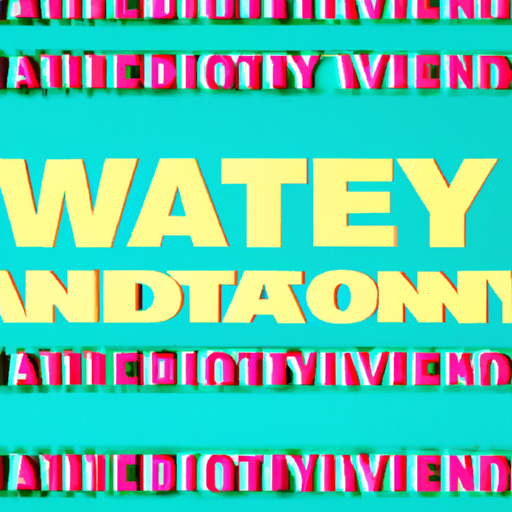-
Table of Contents
- Typography in Motion: Kinetic Text in Graphic Design
- The Rise of Kinetic Text
- The Benefits of Kinetic Text
- Examples of Kinetic Text in Graphic Design
- 1. “The Power of Words” by Andrea Dorfman
- 2. Apple’s “Designed by Apple” Campaign
- 3. Google’s “Year in Search” Videos
- The Impact on User Experience
- Conclusion
Typography in Motion: Kinetic Text in Graphic Design
Typography is an essential element of graphic design, allowing designers to communicate messages effectively through the use of typefaces, fonts, and layouts. In recent years, there has been a growing trend in the use of kinetic text, where typography is brought to life through motion and animation. This article explores the concept of kinetic text in graphic design, its benefits, and its impact on the overall user experience.
The Rise of Kinetic Text
In the digital age, attention spans are shorter than ever, and designers are constantly seeking innovative ways to capture and retain the viewer’s attention. Kinetic text offers a dynamic and engaging solution by adding movement and animation to static typography. This technique has gained popularity across various platforms, including websites, social media, video production, and advertising.
One of the earliest examples of kinetic text can be traced back to the 1960s, with the introduction of the “kinetic typography” technique in film titles. However, it wasn’t until the rise of digital media and advancements in technology that kinetic text became more accessible and widely used.
The Benefits of Kinetic Text
Kinetic text offers several benefits that make it a valuable tool in graphic design:
- Enhanced Communication: By adding motion to typography, designers can emphasize key messages, evoke emotions, and guide the viewer’s attention. Kinetic text allows for a more immersive and interactive experience, making it easier for viewers to understand and remember the information presented.
- Increased Engagement: Static text can often be overlooked or ignored, especially in today’s fast-paced digital environment. Kinetic text, on the other hand, captures attention and encourages viewers to stay engaged with the content. This can be particularly useful in advertising and marketing campaigns, where the goal is to create a lasting impression.
- Improved Storytelling: Kinetic text can be used to enhance storytelling by visually representing the narrative through animated typography. By combining motion, sound, and text, designers can create a more immersive and memorable experience for the audience.
- Brand Differentiation: In a crowded marketplace, it is crucial for brands to stand out and differentiate themselves from competitors. Kinetic text offers a unique and visually appealing way to showcase a brand’s personality and values, helping it to leave a lasting impression on the viewer.
Examples of Kinetic Text in Graphic Design
There are numerous examples of kinetic text being used effectively in graphic design. Let’s explore a few notable examples:
1. “The Power of Words” by Andrea Dorfman
In this short animated film, Andrea Dorfman combines hand-drawn illustrations with kinetic text to convey a powerful message about the impact of words. The animated typography adds depth and emotion to the narrative, making it a compelling and memorable piece of visual storytelling.
2. Apple’s “Designed by Apple” Campaign
Apple is known for its sleek and minimalist design aesthetic, and their “Designed by Apple” campaign is no exception. The use of kinetic text in their promotional videos adds a sense of elegance and sophistication, reinforcing the brand’s commitment to quality and innovation.
3. Google’s “Year in Search” Videos
Each year, Google releases a “Year in Search” video that highlights the most popular search queries and events of the year. These videos feature kinetic text that dynamically reveals the search terms, creating a visually captivating representation of the collective consciousness of the year.
The Impact on User Experience
Kinetic text has a significant impact on the overall user experience, particularly in digital media. Here are a few ways in which it enhances the user experience:
- Visual Appeal: Kinetic text adds visual interest and excitement to the design, making it more engaging and enjoyable for the viewer.
- Information Retention: The movement and animation of kinetic text help viewers retain information more effectively. Studies have shown that people are more likely to remember information presented in a dynamic and interactive format.
- Interactivity: Kinetic text encourages user interaction by inviting viewers to click, scroll, or explore the animated typography. This creates a sense of participation and involvement, leading to a more immersive experience.
- Accessibility: While kinetic text can enhance the user experience for most viewers, it is important to consider accessibility for individuals with visual impairments. Designers should ensure that alternative text or captions are provided to make the content accessible to all users.
Conclusion
Kinetic text has revolutionized the way typography is used in graphic design, offering a dynamic and engaging approach to communication. By adding motion and animation to static text, designers can capture attention, enhance storytelling, and create a memorable user experience. The benefits of kinetic text, such as enhanced communication, increased engagement, improved storytelling, and brand differentiation, make it a valuable tool for designers across various industries.
As technology continues to advance, we can expect to see even more innovative uses of kinetic text in graphic design. Whether it’s in advertising, film, or digital media, kinetic text has proven to be a powerful tool for capturing attention and conveying messages effectively. By embracing this trend, designers can create visually stunning and impactful designs that leave a lasting impression on their audience.
